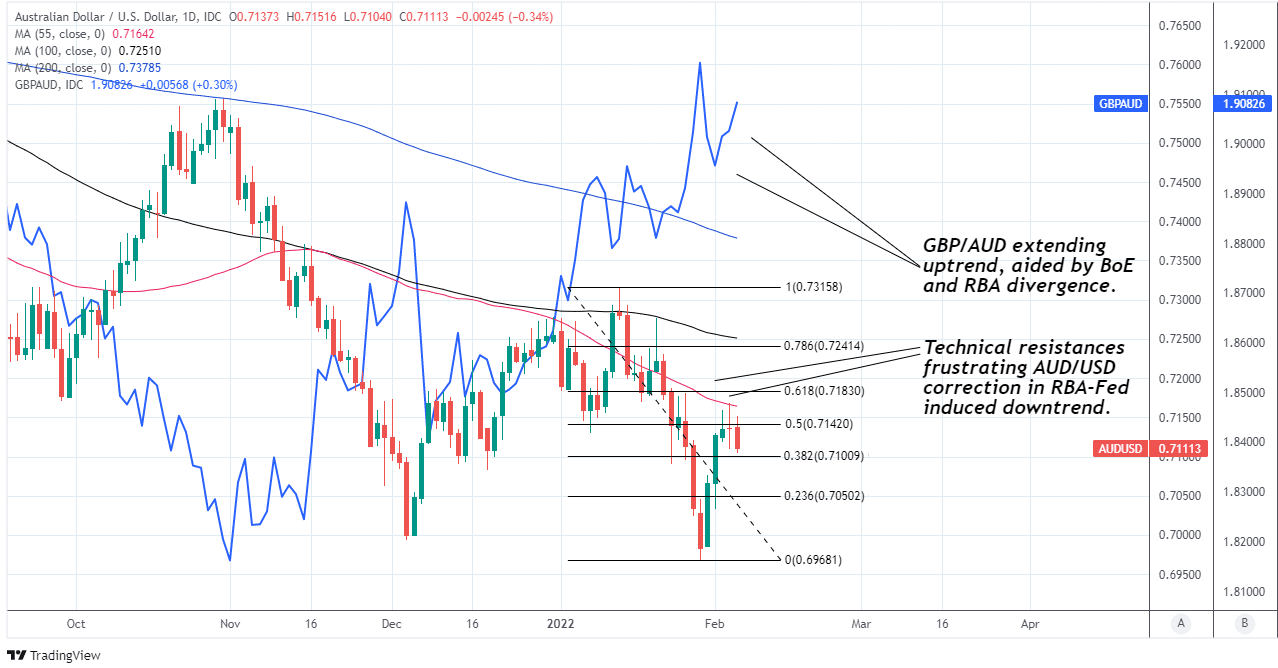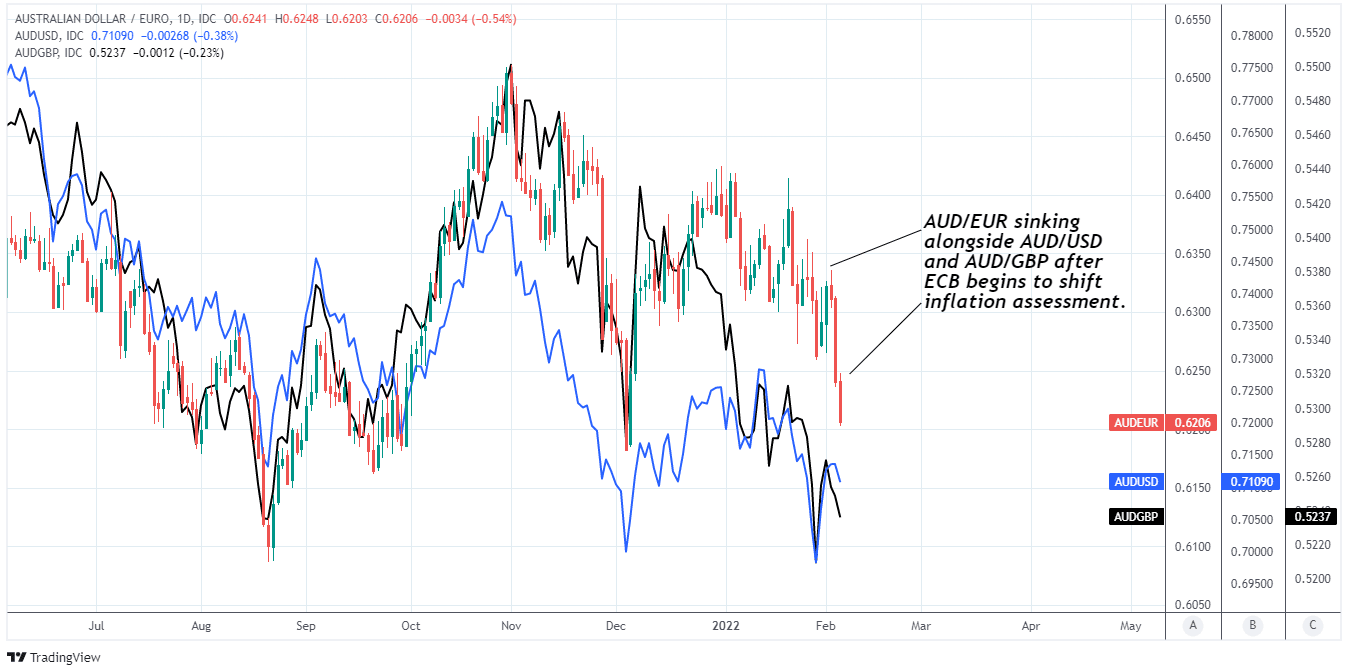Australian Dollar Losses Lift GBP/AUD as RBA Policy Divergence Weighs
- Written by: James Skinner
-
- AUD beats retreat from GBP, USD & EUR
- As RBA lags growing list of central banks
- BoE rate outlook also underpins GBP/AUD
- RBA-Fed divergence weighs on AUD/USD
- As ECB’s inflation shift burdens AUD/EUR

Image © Newtown Grafitti, Reproduced under CC Licensing.
The Australian Dollar slipped lower against a broad basket of currencies including Pound Sterling during the final session of the week in what may be a symptom of policy divergence between the Reserve Bank of Australia (RBA) and its international peers.
The Pound to Australian Dollar rate climbed back toward its highest level since May 2020 on Friday as financial markets contemplated the RBA’s latest statement on monetary policy while also digesting a second consecutive interest rate rise announced by the Bank of England (BoE) in the prior session.
Policymakers in London lifted Bank Rate back to 0.50% in a decision that reversed around two thirds of the interest rate cuts announced at the onset of the coronavirus crisis, although the BoE’s forecasts also warned that multiple further increases could yet be seen in the months ahead.
The BoE’s latest move comes as part of an ongoing response to price pressures that have lifted the inflation far above the two percent target and which are potentially in line to be aggravated by rising rates of wage growth.
"Both the ECB and BoE overnight signalled major concerns with the current inflation environment, expectations that it will prove more persistent, and upward risks to the inflation and interest rate outlook," says David Plank, head of Australian economics at ANZ.
Above: AUD/USD shown at daily intervals alongside GBP/AUD. Major moving-averages and Fibonacci retracements indicate possible areas of technical resistance to any AUD/USD recovery.
- GBP/AUD reference rates at publication:
Spot: 1.9126 - High street bank rates (indicative band): 1.84576-1.8590
- Payment specialist rates (indicative band): 1.8954-1.9030
- Find out about specialist rates, here
- Set up an exchange rate alert, here
"European central banks have a single mandate – inflation. It is roaring, and pandemic levels of accommodation are now completely inappropriate as economies have recovered their COVID-related GDP losses and labour markets are booming," Plank and colleagues wrote in a Friday note to clients.
The BoE’s monetary policy decision lifted Sterling during its immediate aftermath, although it wasn’t just policymakers in London who took action as the European Central Bank (ECB) also indicated that a change in its inflation outlook is also in progress, which has lifted the Euro sharply.
President Christine Lagarde noted on Thursday that uncertainty about the ECB’s inflation outlook has increased and that risks are on the upside along the immediate path ahead, leading many economists to revise their forecasts in favour of an interest rate rise as soon as the latter part of 2022.
This delivered a significant boost to the Euro and weighed on the AUD/EUR exchange rate, which has since begun to close the gap between itself and an AUD/USD rate that had already fallen heavily due to a Federal Reserve (Fed) policy stance that has steadily become more hawkish in recent months.
{wbamp-hide start}
{wbamp-hide end}{wbamp-show start}{wbamp-show end}
“Despite ongoing reports of labour shortages, most firms in the Bank's liaison program are not anticipating wage increases to move beyond the 2 to 3 per cent range over the coming year (Graph 4.21). This is consistent with other surveys of wages growth expectations,” the Reserve Bank of Australia said in its Friday statement on monetary policy.
The RBA, on the other hand, has continued to emphasise the differences between its own monetary policy situation and those faced by other central banks elsewhere in the world, which has been a significant weight upon Australian Dollar exchange rates during the year leading into February.
Governor Philip Lowe set out these differences in detail during a Wednesday speech to the National Press Club of Australia where he emphasised that growth in workers’ wage packets has been far more significant in the UK, U.S. and other jurisdictions than it has been down under in Australia.
“The Governor indicated in his speech and Statement that the sustainability of the current inflation lift back into the target zone will depend on the pace of normalisation of the current supply chain shocks to goods prices and wages. In the SOMP the Bank appears to be less confident about a swift resolution of the supply chain disruptions,” says Bill Evans, chief economist at Westpac.
Above: AUD/EUR shown at daily intervals alongside AUD/USD and AUD/GBP.
Secure a retail exchange rate that is between 3-5% stronger than offered by leading banks, learn more.
Although Australian inflation rates have risen significantly in recent months and could yet remain elevated for some time, the RBA has judged that wage growth of three percent or more will be necessary in order to sustainably deliver inflation at the bank’s targeted rate of around 2.5%.
Despite recent increases in overall inflation, all of the latest indications are that wage growth will still not be sufficient for this anytime soon, which is why the RBA has continued to insist that its cash rate is likely to remain at its present historic low of 0.1% for quite some time yet.
“Notwithstanding our forecasts, today's updated inflation profile implies the RBA is very comfortable for underlying inflation to be at the top of their target band given they have not yet started the process of normalising the cash rate,” says Gareth Aird, head of Australian economics at Commonwealth Bank of Australia.
“Overall, we believe there is considerable scope for the inflation and wages data over H1 22 to come in stronger than the RBA has forecast. This leaves us comfortable with our call that the RBA commences raising the cash rate in August 2022,” Aird and colleagues said in a Friday research note.
While the RBA has impressed upon financial markets that its cash rate is unlikely to rise much before the year 2024, many economists suspect that Australian wage packets and inflation will pick up sufficiently enough to eventually bring forward the timing of an initial increase in the bank’s cash rate.
The trouble for the Australian Dollar is that with the cash rate down near to zero, the RBA hasn’t been willing to take any chances by lifting it too early.
That’s because for a long time before the coronavirus crisis came along, the bank was already cutting its interest rate due to a lengthy period in which Australian inflation pressures were too scarce for the RBA’s target of 2.5% to be met.






